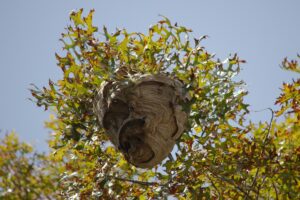 Wasp nests become more conspicuous during late summer. Where the nest is located will influence what you decide to do with it. Jeff Hahn, University of Minnesota Extension Entomologist provides the following information for dealing with wasp nests.
Wasp nests become more conspicuous during late summer. Where the nest is located will influence what you decide to do with it. Jeff Hahn, University of Minnesota Extension Entomologist provides the following information for dealing with wasp nests.
The first option is to ignore it
If the nest is located away from human activity and the chance of stings are minimal, then leave it alone. When freezing temperatures arrive in fall, the queen and all the workers are killed. They do not survive the winter. If you can wait until then, doing nothing is a valid decision.
However, if there is an unacceptable risk of stings and October or November is too long to put up with them, then treat the nests.
There are three general wasp nest types: exposed nests, ground nests, and hidden nests. Each is controlled differently.
Regardless of what kind of nest it is, treat it in late evening when wasps are no longer flying in and out of the nest. Do not try to control nests in the daytime when wasps are active and there is a greater chance of stings.
Exposed wasp nests
An exposed nest is easily seen. It hangs from a horizontal surface, such as the eaves of a home or the branch of a tree. Treating this kind of nest is typically a straightforward task that you can do yourself.
- Use an aerosol can of insecticide labelled for wasps and hornets and spray into the nest entrance.
- One application is usually all that is necessary to eliminate them.
- If there are survivors the next day, retreat the nest.
Ground nests
Wasps also commonly nest in the ground, especially in old rodent burrows. You can see the opening that leads to the nest, but you can’t see the actual nest itself.
The only reason you know a nest is present is from the steady stream of wasps flying back and forth.
- The best control is to apply a dust or granular insecticide to treat the nest.
- Liquid products are less effective and should be avoided.
- Once you know all the wasps are dead, fill in the entrance.
- While old nests are not reused, the burrow could be used to construct a new nest next year.
Hidden wasp nests
Nests concealed inside buildings are very challenging to treat. Like ground nests, all that is visible is the space where the wasps fly back and forth but the actual nest can not be seen. It is common for wasps to nest in wall voids, attics, spaces under stairs and similar sites.
First, a couple of don’ts:
- Don’t spray the nest opening. This is not effective as the nest does not line up where this opening is located, so the insecticide does not actually get into the nest and affect the colony.
- Don’t plug up the opening to try to prevent the wasps from getting out.
In both cases, the wasps will just go another direction, which too many times means into the inside of your home. It is common to be suddenly inundated with lots of wasps after sealing or spraying a nest opening.
- The best control is to apply a dust into the opening.
- This product must be labeled for use in and around homes.
- One common example is Bonide’s Spider & Ground Bee Killer (this product can also be used for ground nests).
Consider a professional
It is always an option to hire a professional pest control technician to treat a wasp nest anytime you would rather not deal with it yourself. This is especially true for hidden nests which are very challenging to treat.
For more information, see University of Minnesota’s Wasps and bees information site at: https://tinyurl.com/y6fmwk4d
Written by: Bill Halfman, Extension Monroe County, Agriculture Agent, email: william.halfman@wisc.edu
For more information, please contact: Carolyn Ihde, Agriculture Agent, Extension Richland County by email: carolyn.ihde@wisc.edu




